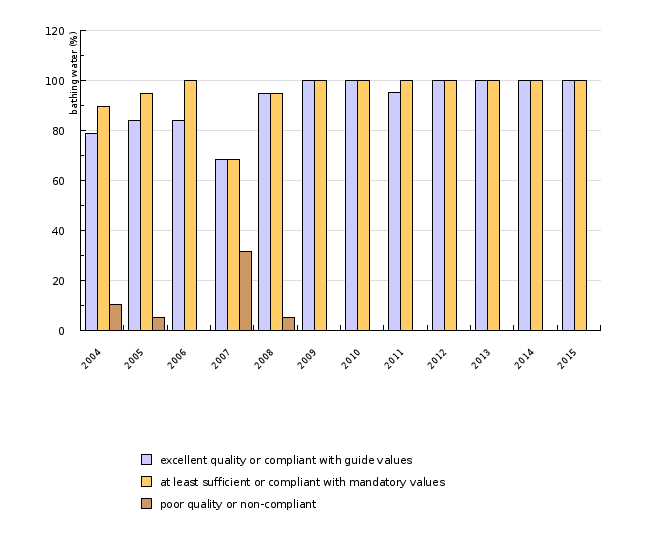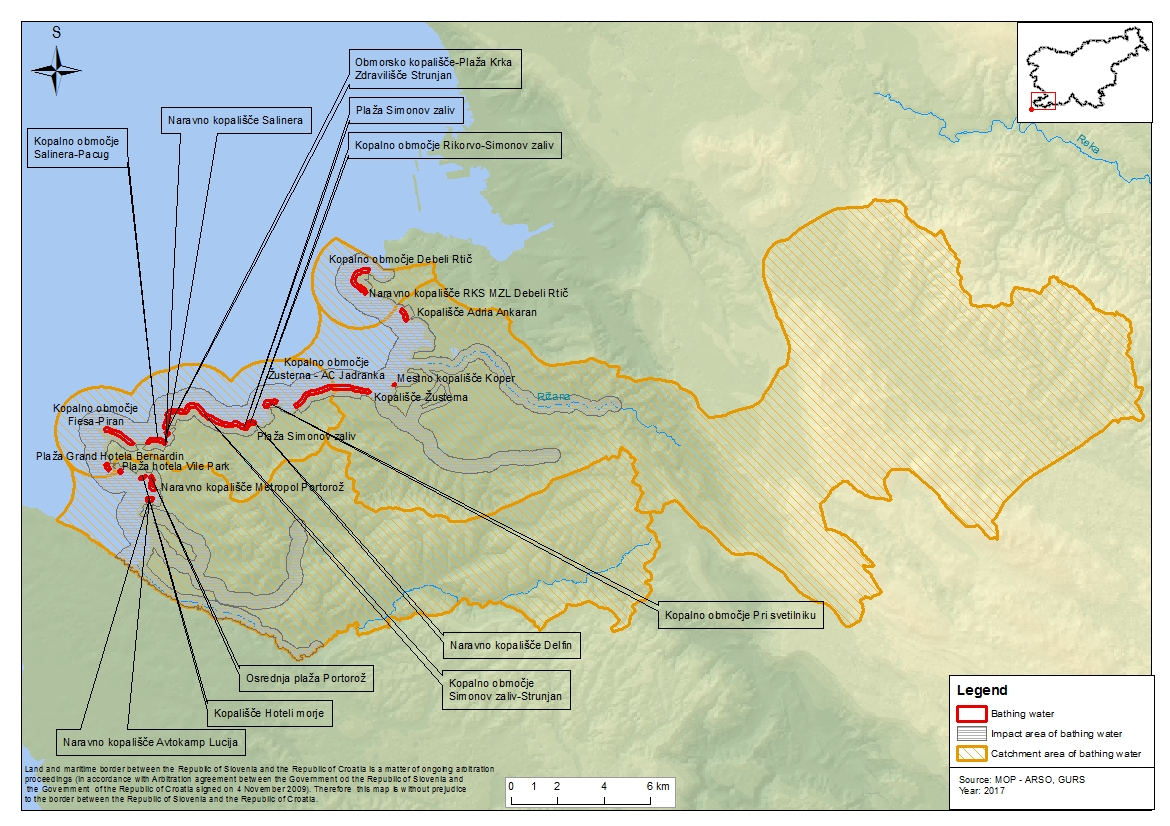[MR05] Bathing water quality in costal zones

Key message

The quality of bathing water along the Slovenian coast is excellent, which ranks Slovenia at the top among the EU countries.
Definition
This indicator shows coastal sea bathing water in Slovenia and its quality. A bathing area is a section of coastal water intended exclusively for bathing. Bathing areas are designated where a large number of people bathe or expect to bathe or where bathing is carried out as a direct use of water for the activity of bathing areas.
Bathing water is divided as follows:
- Bathing areas – areas in the natural environment where the public bathes at their own risk, while water quality monitoring is provided;
- Natural bathing sites – bathing areas that have a manager and a permit for direct use of water, while bathing is organised in accordance with the legislation governing prevention of drowning.
Charts
Database on bathing water quality, National institute of Public Health (2004-2009), Slovenian Environment Agency, 2017
| 2004 | 2005 | 2006 | 2007 | 2008 | 2009 | 2010 | 2011 | 2012 | 2013 | ||
|---|---|---|---|---|---|---|---|---|---|---|---|
| excellent quality or compliant with guide values | number | 15 | 16 | 16 | 13 | 18 | 20 | 21 | 20 | 21 | 21 |
| at least sufficient or compliant with mandatory values | number | 17 | 18 | 19 | 13 | 18 | 20 | 21 | 21 | 21 | 21 |
| poor quality or non-compliant | number | 2 | 1 | 0 | 6 | 1 | 0 | 0 | 0 | 0 | 0 |
| excellent quality or compliant with guide values | % | 78.9 | 84.2 | 84.2 | 68.4 | 94.7 | 100 | 100 | 95.2 | 100 | 100 |
| at least sufficient or compliant with mandatory values | % | 89.5 | 94.7 | 100 | 68.4 | 94.7 | 100 | 100 | 100 | 100 | 100 |
| poor quality or non-compliant | % | 10.5 | 5.3 | 0 | 31.6 | 5.3 | 0 | 0 | 0 | 0 | 0 |
| 2014 | 2015 | ||||||||||
| excellent quality or compliant with guide values | number | 21 | 21 | ||||||||
| at least sufficient or compliant with mandatory values | number | 21 | 21 | ||||||||
| poor quality or non-compliant | number | 0 | 0 | ||||||||
| excellent quality or compliant with guide values | % | 100 | 100 | ||||||||
| at least sufficient or compliant with mandatory values | % | 100 | 100 | ||||||||
| poor quality or non-compliant | % | 0 | 0 |
Goals
To monitor the quality of bathing water and to provide or improve the quality of bathing water with the purpose of protecting the bathers' health.
Comment
Before Slovenia joined the EU (2004), bathing water quality was regularly monitored at 32 locations – managed bathing sites and areas where bathers traditionally gathered and bathed in large or small numbers. In 2004, regular national monitoring was initiated in accordance with the first European Bathing Water Directive. The monitoring is regularly carried out at managed bathing sites (or ‘natural bathing sites’) and at bathing areas – sections of coastal sea where people traditionally bathe in large numbers.
In 2004, 19 bathing water sites were designated and in 2008, the list was extended to 22 bathing sites. These are divided into natural bathing sites and bathing areas. By 2010, safe bathing and monitoring of bathing water quality was provided by bathing site managers at 14 natural bathing sites. At 6 bathing areas in the period 2004–2008 and at 7 areas in 2009, monitoring of bathing water quality was carried out by the Slovenian Environment Agency. From 2010 onwards, monitoring at all bathing water sites (i.e. natural bathing sites as well as bathing areas) has been provided by the Slovenian Environment Agency and carried out through regional institutes of public health and the National Laboratory of Health, Environment and Food.
In order to protect bathers’ health, bathing water quality is checked every 14 days during bathing season (from 15 June to 30 September in the period 2004–2008 and from 1 June to 15 September in 2009) and weekly in the period 2004–2009 at bathing sites with variable water quality. Water samples were tested for microbiological, physical and chemical parameters in accordance with state regulations and EU directives.
The data gathered from the monitoring of bathing waters in accordance with the first European Bathing Water Directive (76/160/EEC) on the basis of sensory evaluation and laboratory tests of three physical and chemical parameters (detergents, mineral oils, phenols in the period 2004–2009) do not show chemical pollution. Microbiological parameters (total coliform bacteria, faecal coliforms and faecal streptococci [enterococci]) that were tested in the period 2004–2009 showed only occasional short-term faecal pollution, which usually occurred during or after abundant precipitation;
The sources of bathing water pollution are municipal and industrial wastewater, agriculture, surface runoff and eventual spillover during downpours. Other causes of pollution of bathing water and the surrounding areas include bathers' urine, faeces, excretions from the nose, throat, lung and eyes as well as animal faeces (dogs, birds, rodents). The concentration of microbes in the water depends on water currents, tidal action, water temperature, solar radiation, water salinity, sedimentation and water quality.
Experience shows that the most common negative consequences from bathing in coastal waters include infections of the skin, eyes and ear canal, the gastrointestinal tract, the acute febrile respiratory tract, etc. Algal blooms in bathing water can cause health problems as well (allergies, vomiting, diarrhea, etc.). Key measures include informing the public, detection of pollution sources and reduction or elimination of pollutants. Additional attention is required while walking on slippery or wet surfaces. Also, overexposure to ultraviolet radiation is often related to activities in and near water.
The distinctive indicators of faecal pollution (intestinal enterococci and Escherichia coli) have been monitored since 2010. According to tests, there has not been any faecal pollution of coastal bathing waters. Due to the variability of results in the past years and a different system of quality assessment, we cannot speak of notable improvement or deterioration of bathing water quality. However, the state has been more stable since 2010. Bathing water quality since 2010 has been most often assessed to be excellent, which ranks Slovenia at the top among EU countries.
In accordance with new regulations, bathing water profiles were prepared for individual bathing water sites in 2011. These profiles include a description of all important natural characteristics of the bathing water and its catchment area as well as a definition and description of all important pollution sources that are a result of human activity and may affect the quality of the bathing water. Bathing water profiles are presented on the Slovenian Environment Agency website (http://www.mop.gov.si/si/delovna_podrocja/voda/kopalne_vode/seznam_in_pr...).










